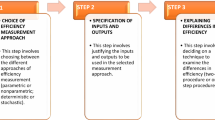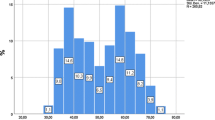Abstract
This study examines the relationship between academic seniority and research productivity through a study of a sample of academics at Australian law schools. To measure research productivity, we use both publications in top law journals, variously defined, and citation metrics. A feature of the study is that we pay particular attention to addressing the endogeneity of academic rank. To do so, we use a novel identification strategy, proposed by Lewbel (Journal of Business and Economic Statistics 30:67–80, 2012), which utilises a heteroscedastic covariance restriction to construct an internal instrumental variable. Our main finding is that once endogeneity of academic rank is addressed, more senior academics at Australian law schools do not publish more articles in top law journals (irrespective of how top law journals are defined) than their less senior colleagues. However, Professors continue to have greater impact than Lecturers when research productivity is measured in terms of total citations and common citation indices, such as the h-index and g-index.
Similar content being viewed by others
Notes
These studies are based on the working paper version of Lewbel (2012).
FOR is the Australian Bureau of Statistics Field of Research. In ERA 2010 all journals were classified according to FOR codes. Law is FOR 18.
In a press release on May 30 2011 announcing that the ERA rankings would no longer be employed, the Minister for Innovation, Industry, Science and Research, Senator Kim Carr stated: ‘There is clear and consistent evidence that the [ERA journal] rankings are being deployed inappropriately in some quarters of the sector, in ways that would produce harmful outcomes, and based on a poor understanding of the actual role of the rankings. One common example was the setting of targets for publications in A and A* journals by institutional research managers. In light of these two factors—that ERA could work perfectly well without the rankings, and that their existence was focussing ill-informed, undesirable behaviour in the management of research—I have made the decision to remove the rankings based on the Australian Research Council’s expert advice”..
For example see Legal Eagle, ‘ERA Journal Rankings are Dead—Hurrah, Hurrah!’ http://skepticlawyer.com.au/2011/05/31/era-journal-rankings-are-dead-hurrah-hurrah, posted May 31, 2011 (last accessed June 27, 2011).
The top journals might be defined with reference (informally) to the ERA 2010 rankings, other lists such as the Australian Business Dean’s Council (ABDC) list. See http://www.abdc.edu.au/3.43.0.0.1.0.htm, last accessed 4 October 2012 for discipline specific rankings.
References
Abramo, G., D’Angelo, C. A., & Di Costa, F. (2011). Research productivity: are higher academic ranks more productive than lower ones? Scientometrics, 88, 915–928.
Allison, P. D., Long, J. S., & Kruze, T. K. (1974). Productivity difference among scientists: evidence for accumulative advantage. American Sociological Review, 47, 615–625.
Amara, N., & Landry, R. (2012) “Counting citations in the field of business and management: why use google scholar rather than Web of Science”, Scientometrics (in press).
Australian Academy of Sciences (2008) Review of the Australian Higher Education Discussion Paper, http://www.science.org.au/reports/31july08.pdf (last accessed September 3, 2012).
Australian Government (2008) Australian Research Council: Indicators, http://www.arc.gov.au/era/indicators.htm (last accessed September 3, 2012).
Belfield, C. R., & Kelly, I. R. (2010) “The Benefits of Breastfeeding Across the Early Years of Childhood. NBER Working Paper 16496.
Blackburn, R. T., Behymer, C. E., & Hall, D. E. (1978). Correlates of faculty publications. Sociology of Education, 51(2), 132–141.
Blackburn, R. T., & Lawrence, J. H. (1995). Faculty at work: motivation, expectation, satisfaction. Baltimore: Johns Hopkins University Press.
Carayol, N., & Matt, M. (2004). Individual and collective determinants of academic scientists’ productivity. Information Economics and Policy, 18, 55–72.
Coupe, T., Smeets, V., & Warzynski, F. (2006). Incentives, sorting and productivity along the career: evidence from a sample of top economists. Journal of Law Economics and Organization, 22, 137–167.
Denny, K., & Oppedisano, V. (2010) “Class Size Effects: Evidence Using a New Estimation Technique. UCD Geary Institute Working Paper 2010/51.
Department of Education, Employment and Workplace Relations (DEEWR) (2008) “Review of Australian Higher Education”, Discussion Paper, June, Canberra, DEEWR.
Egghe, L. (2006). Theory and practice of the g-index. Scientometrics, 69, 131–152.
Ellison, G. (2010). How Does the Market Use Citation Data? The Hirsch Index in Economics. Working Paper: National Bureau of Economics Research. 16419.
Garfield, E. (1970) “Citation measures used as an objective estimate of creativity”, Current Contents, # 26, August 26, 120-121.
Garfield, E. (1971) “Publication counting versus citation counting in evaluating research”, Current Contents, # 9, June 2, 179-181.
Garfield, E., & Welljams-Dorof, A. (1992). Of nobel class: a citation perspective on high impact research authors. Theoretical Medicine and Bioethics, 13(2), 117–135.
Gaston, J., Lantz, H. R., & Snyder, C. R. (1975). Publication criteria for promotion in PhD graduate departments. American Sociologist, 10, 239–242.
Gonzalez-Brambila, C., & Veloso, F. M. (2007). The determinants of research output and impact: a study of Mexican researchers. Research Policy, 36, 1035–1051.
Goodwin, T. H., & Sauer, R. D. (1995). Life cycle productivity in academic Research: revidence from cumulative publication histories of academic economists. Southern Economic Journal, 62, 728–743.
Green, R. G. (1998). Faculty rank, effort and success. Journal of Social Work Education, 34(3), 415–426.
Harzing, A.W. (2012) “A preliminary test of Google Scholar as a source of citation data: a longitudinal study of nobel prize winners”, Scientometrics (in press).
Hirsch, J.E. (2005) “An index to quantify an individual’s scientific research output”, Proceedings of the National Academy of Science, 102, 16569-16572.
Kasten, K. L. (1984). Tenure and Merit Pay as Rewards for Research, Teaching and Service at a Research University. Journal of Higher Education, 55, 500–514.
Kelly I.R., D.M. Dave, J.L. Sindelar and W.T. Gallo (2011) “The Impact of Early Occupational Choice on Health Behaviors” NBER Working Paper 16803.
Lewbel, A. (2012). Using heteroscedasticity to identify and estimate mismeasured and endogenous regressor models. Journal of Business and Economic Statistics, 30(1), 67–80.
Lissoni, F., Mairesse, J., Montobbio, F., & Pezzoni, M. (2011). Scientific productivity and academic promotion: a study on French and Italian Physicists. Industrial and Corporate Change, 20(1), 253–294.
McNally, G. P. (2010). Scholarly productivity, impact and quality among academic psychologists at group of eight universities. Australian Journal of Psychology., 62(4), 204–215.
Posner, R. (2000). An economic analysis of the use of citations analysis in the law. American Law and Economics Review, 2, 381–406.
Puuska, H. M. (2010). Effects of scholar’s gender and professional position on publishing productivity in different publication types: analysis of a Finnish University. Scientometrics, 82, 419–437.
Ramsey, I., & Stapledon, G. (1997). A citation analysis of Australian Law Journals. Melbourne University Law Review, 21, 676–692.
Rauber, M., & Ursprung, H. W. (2008). Life cycle and cohort productivity in economic research: the case of Germany. German Economic Review, 9(4), 431–456.
Sabia, J. J. (2007a). Reading, writing and sex: the effect of losing virginity on academic performance. Economic Inquiry, 45(4), 647–670.
Sabia, J. J. (2007b). The effect of body weight on adolescent academic performance. Southern Economic Journal, 73(4), 871–900.
Salthouse, T. A., McKeachie, W. J., & Lin, Y. G. (1978). An experimental investigation of factors affecting university promotion decisions. Journal of Higher Education, 49, 177–183.
Siegfried, J. J., & White, K. J. (1973). Financial rewards to research and teaching: a case study of academic economists. American Economic Review (Papers and Proceedings), 63(2), 309–315.
Smeby, J., & Try, S. (2005). Departmental contexts and faculty research activity in norway”. Research in Higher Education, 46(6), 593–619.
Smyth, R. (1998). Academic writing and the courts: a quantitative study of the Influence of legal and non-legal periodicals in the high court. University of Tasmania Law Review, 17(2), 164–185.
Smyth, R. (2012). Who Publishes in Australia’s Top Law Journals? University of New South Wales Law Journal, 35(1), 203–247.
Talib, A. A. (2002). The research assessment exercise and motivation: a note on the difference in the impact of the active researchers and the non-active. Higher Education Review, 34(2), 51–59.
Thomson Reuters (2011) “Thomson Reuters Predicts Nobel Lauretes” http://thomsonreuters.com/content/press_room/science/2011-citation-laurettes (last accessed September 3, 2012).
Tien, F. F. (2000). To what degree does the desire for promotion motivate faculty to perform research? Testing the expectancy theory. Research in Higher Education, 41(6), 723–752.
Tien, F. F., & Blackburn, R. T. (1996). Faculty rank system, research motivation and faculty research productivity. Journal of Higher Education, 67(1), 2–22.
Tressler, J., & Anderson, D. L. (2012). Citations as a measure of the research output of New Zealand’s economics departments: the problem of ‘long and variable Lags’. Agenda, 19(1), 17–40.
Ventura, O. N., & Mombru, A. W. (2006). Use of bibliometric information to assist research Policy making: a comparison of publication and citation profiles of full and associate professors at a School of Chemistry in Uruguay. Scientometrics, 69(2), 287–313.
Xie, Y., & Schauman, K. A. (1998). Sex differences in research productivity: new evidence about an Old Puzzle”. American Sociological Review, 63(6), 847–870.
Author information
Authors and Affiliations
Corresponding author
Rights and permissions
About this article
Cite this article
Mishra, V., Smyth, R. Are more senior academics really more research productive than junior academics? Evidence from Australian law schools. Scientometrics 96, 411–425 (2013). https://doi.org/10.1007/s11192-012-0886-3
Received:
Published:
Issue Date:
DOI: https://doi.org/10.1007/s11192-012-0886-3




